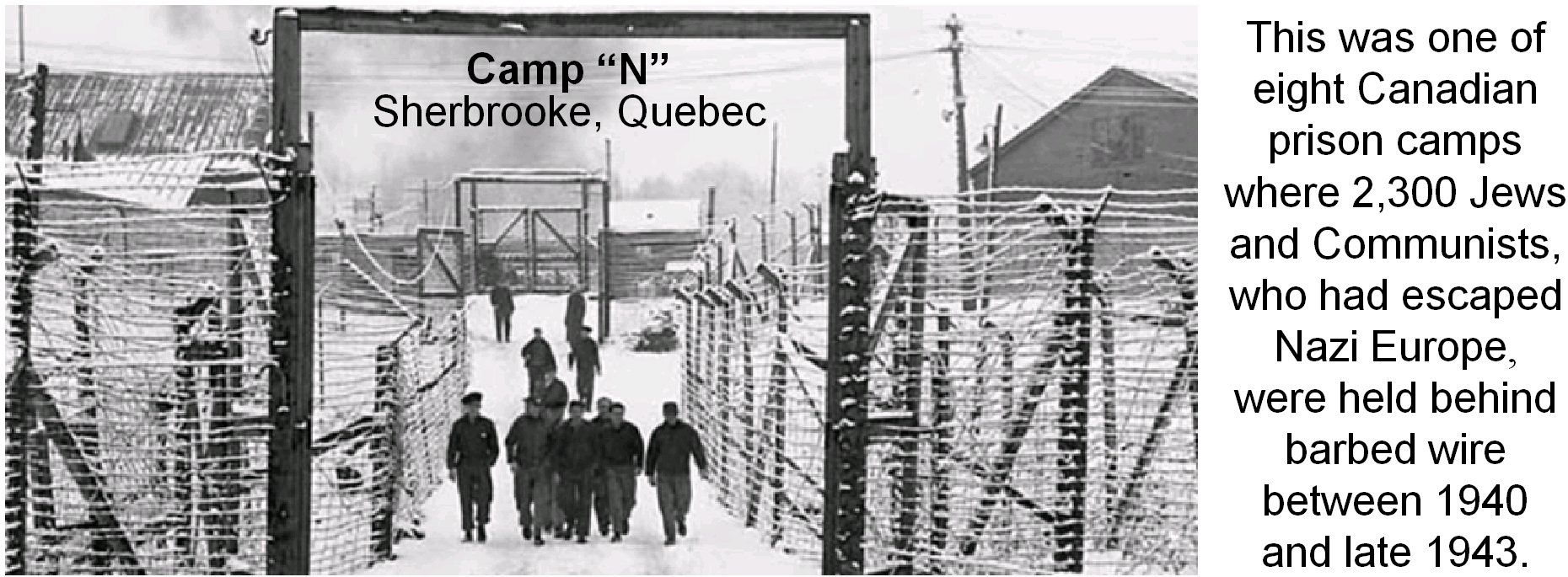These Captive Canada articles look at the persecution and internment of Jews and Reds in both Csarist Russia and Canada. Few Canadians know much about the "failed" Russian revolution (1905-07). Radicals (including many Jewish activists) organised huge strikes and mass protests which sparked Csarist pogroms, mass executions and the internment of 100s of thousands. AntiSemitism and antiRed sentiments were also rampant in Canada. When Jewish & communist refugees fled fascism, the UK interned them and then shipped them to Canada. The Liberal govt interned 2,300 of these unwanted refugees between 1940 and late 1943!
htm The Russian Revolution of 1905-1907
htm Racist Roots of Toryism and antiSemitism
htm From Czarist Pogroms to Canada's WWII Internment Camps for Jews and Communists
 This article was written for and first appeared in
This article was written for and first appeared in
Captive Canada:
Renditions of the Peaceable Kingdom at War,
from Narratives of WWI and the Red Scare
to the Mass Internment of Civilians
Issue #68 of Press for Conversion (Spring 2016), pp.38-39. Published by the Coalition to Oppose the Arms Trade (COAT). If you quote this article, please cite the source above. And, please consider subscribing, ordering a copy &/or donating. Thanks!
The Russian Revolution of 1905-1907
By Richard Sanders, Coordinator, Coalition to Oppose the Arms Trade (COAT)
 Revolution across the Russian Empire was sparked in 1905, when Czarist troops shot and killed a thousand or more peaceful protesters in St. Petersburg. In the Russian, Polish, Ukrainian, Finnish, Latvian and Estonian protests that followed this “Bloody Sunday” massacre, millions joined general strikes and mass rallies. To crush this struggle for justice, democracy and labour rights, imperial troops killed thousands of socialists and anarchists, and interned some 300,000.
Revolution across the Russian Empire was sparked in 1905, when Czarist troops shot and killed a thousand or more peaceful protesters in St. Petersburg. In the Russian, Polish, Ukrainian, Finnish, Latvian and Estonian protests that followed this “Bloody Sunday” massacre, millions joined general strikes and mass rallies. To crush this struggle for justice, democracy and labour rights, imperial troops killed thousands of socialists and anarchists, and interned some 300,000.
In 1909, Britain’s Parliamentary Russian Committee, which included an Anglican Bishop and two dozen MPs, published The Terror in Russia, by Peter Kropotkin, a Russian geographer, economist, atheist, evolutionary theorist and anarcho-communist.1 Using reports by the Czarist regime, he showed that 2,350 civilians had been sentenced to death and executed in Russia between 1905 and 1908. In addition, 1,330 civilians were shot without sentence and hundreds of soldiers were executed for mutiny. Other state murders included those “shot in the streets”2 by Csarist forces during huge protests and strikes.
Kropotkin also cited official data on 221,000 Czarist prisoners, and estimated that 50,000 to 100,000 others were being held in local “police lock-ups.” The crackdown also created more than 700,000 internal refugees in European Russia. “[I]n consequence of repression after strikes,” said Kropotkin, these people were forced to become “mere outlaws wandering from one city to another...without any possibility of returning to their native places and to their previous occupations.”3
As historian Orest Martynowych noted: “the [Ukrainian Canadian] intelligentsia were swelled by immigrants from eastern (Russian) Ukraine, who arrived after the revolution of 1905.”4 These “revolutionary intellectuals,” said historian Ross McCormack, soon took on leadership roles in Canada’s “emerging eastern European socialist movement.”5
The elites of Canada’s church and state became more openly phobic. For example, in 1911, an official Catholic paper “sowed panic... describing Montreal as a hotbed of Russian anarchists who” as “veterans of the [1905] mutiny on the battleship Potemkin,” were “the most dangerous elements of Russian Jewish nihilism.”6
References/Notes
1. Born a prince, Kropotkin renounced his titles and became a scientist. Invited by former socialist Prof. James Mavor to lecture in Toronto, he toured Canada in 1897, visiting Mennonite communities. Urged on by Kropotkin and Leon Tolstoy, Mavor convinced Canadian authorities to allow thousands of Russian Doukhobors to create prairie communes. Many were interned in WWII labour camps for pacifist beliefs.
2. Peter Kropotkin, The Terror in Russia, 1909, pp.34-35.
http://archive.org/stream/2917702.0001.001.umich.edu
3. Ibid., pp.7-9.
4. Orest Martynowych, Village radicals and peasant immigrants: The social roots of factionalism among Ukrainian immigrants in Canada, 1896-1918, 1978, pp.101-102. (MA thesis, Grad. Studies, University of Manitoba.)
http://www.collectionscanada.gc.ca/obj/s4/f2/dsk2/ftp04/MQ36804.pdf
5. A.Ross McCormack, Reformers, Rebels, and Revolutionaries: The Western Canadian Radical Movement, 1899-1919, p.65.
http://books.google.it/books?id=qixxVyYBVVAC
6. Jacques Langlais and David Rome, Jews & French Quebecers: Two Hundred Years of Shared History, 1991, p.45.
http://books.google.ca/books?id=qQLpVlQ61DMC
Racist Roots of Toryism and antiSemitism
By Richard Sanders, Coordinator, Coalition to Oppose the Arms Trade (COAT)
Speaking of immigrants to the US, Canada’s Prime Minister Sir John A.MacDonald, said in 1890: "Look at the mass of foreign ignorance and vice which has flooded that country with communism, socialism, atheism and all other isms."1 Besides being an avid antiCommunist and a devote Christian, Sir John was an avid white supremacist. In 1885, he told Parliament that Blacks and Asians were a different species from what he called "the Aryan race." Clarifying the economic basis of his racist xenophobia, he said he did not want a "mongrel race to disturb the labour market."2
Hatred toward nonChristians was also rampant. In 1903, Thomas Sproule, MP, told Parliament that "Canada is...the dumping ground for the refuse of every country in the world." Particularly offensive to this Tory were east Europeans, whom he listed as "Galicians" [Ukrainians], "Poles" and "Russian Jews."3
Although Sproule was no Social Gospeller, he was—like most leaders of this reform movement—a devout Methodist. Tories, like Sproule and MacDonald, also shared the Social Gospel’s faith in AngloProtestant superiority. Sproule was not only a Conservative MP (1878-1915) and Senator (1915-1917), he was also Speaker of the House (1911-1915) when the War Measures Act was passed unanimously with Liberal support in 1914.
Sproule was also Grand Master of the Grand Orange Lodge of British America (1902-1911) and became Imperial Grand President of the global Imperial Grand Orange Council in 1906.4 As such, he led an ultraright, extremist group of AngloProtestant, Catholic-hating anti- Semites, loyal to the British empire.
In 1906, while Csarist forces were crushing a revolution, Sproule ranted in the House about "Russian Jews" coming to Canada. Calling them a "very undesirable," "filthy looking class" plying their "Jew trade," he said they "are not the class of people likely to elevate...the civilization of the Canadian people." Such "riff-raff," he said, are "not likely to assimilate with our people to any advantage."5 Sproule also said eastern Europeans are
"not in any way to the manor born ...[and] are imbued with instincts and natures which have not...any tendency to elevate humanity but rather to lower it in every particular."6
He also espoused the popular view, shared by progressive Social Gospellers, that
"any nation goes up or down on the scale of civilization in proportion as that nation maintains the principles of the Christian religion....as based upon the word of God."7
References
1. "Never Mind Sir John," Lawrence [Kansas] Daily Journal, October 23, 1890, p.1.
http://www.newspapers.com/newspage/64427156/
2. Hansard, May 4, 1885, 1588-1589.
3. Hansard, July 14, 1903, 6591.
4. Report of proceedings, Imperial Grand Orange Council, 1906.
http://archive.org/details/reportofproceedi00loya
5. Hansard, June 20, 1906, 7298.
6. Hansard, July 14, 1903, 6591.
7. Hansard, June 20, 1906, 5643.

From Csarist Pogroms to Canada’s WWII
Internment Camps for Jews and Communists
By Richard Sanders, Coordinator, Coalition to Oppose the Arms Trade (COAT)
Blamed for strikes and protests in the 1905-1907 revolution, Russian Jews were targeted by Czarist forces and attacked by vigilantes. Fleeing state terror and privatised progroms, thousands sought refuge in Canada. Canada’s Jewish population rose from 16,000 in 1901 to 76,000 in 1911. While 2,400 Jews entered Canada per year between 1901 and 1904, the annual average soon rose to 7,700 (1905-1908). Most were from Russia, just as 85% of America’s 1910 Jewish population was Russian.1
Journalist Israel Medres, who came to Montreal from Russia in 1922, said “a migration of unprecedented size arrived in the Quebec metropolis following the Russian revolution of 1905.”2 They were met by an antiSemitic/antiRed hatred that typified Canada, especially its elites. In 1907, Liberal MP, Armand Lavergne, decrying the “mongrel population...that comes in by flocks,” told Parliament that in 1906
“Montreal [had]...a socialist parade with the red flag of anarchy at its head, and possibly this year, if the police do not interfere, we shall have a repetition of that procession. In a few years the Jewish population of Montreal has increased from 8,000 to 40,000.”3
Arguing that only “a more desirable class of people” be allowed through Canada’s gates, Lavergne warned that “[o]therwise we shall be strangers in our own country and the foreigners will be the masters.”4
In the 1930s and 1940s, Canada refused to aid Jewish refugees fleeing Nazi Europe. In 1939, the Liberal government even deployed our Navy to expel a passenger ship because it held 900 Jewish refugees. As detailed in None is Too Many, Canadian elites were rabidly antiSemitic, especially in Quebec where:
“Church leaders, nationalist politicians, and the social elite united...in support of a boycott of Jewish owned businesses, ...and...bar Canada’s door to the further admission of Jews.”5
Less known is that beginning in 1940, Canada’s Liberals locked up 2,300 European refugees, mostly Jews, in eight POW camps in Quebec, Ontario and New Brunswick. Having escaped Nazi Europe, these civilians were put in British and then Canadian internment camps, with fascists. After July 1941, these Jewish and communist refugees remained captive, but behind the barbed wire of Canadian “refugee camps.” Many were not freed til late 1943.
Hundreds of the antiNazi refugees held in Canada were communists. These POWs were of prime concern to authorities. In 1941, over 45% of the 500 internees in Camp Farnham, near Montreal, were Communist supporters. Camp authorities reported that inmates had elected “Communists or Communist sympathizers...for most of the posts.” When indignant Reds became “assertive and vocal,” seven of their “ring-leaders” were targeted for transfer to the prison camp on Île Ste. Hélène (future site of Expo 67). Other inmates reacted to this with a mass, hunger strike.6
Journalist Eric Koch, who was interned in a Quebec POW camp during WWII, said “Communists were in the forefront of those making demands.” As a Jew who fled to Britain from Nazi Germany, Koch said “Communists were activists and trouble-makers” who agitated for refugee rights from within the Canadian camps.7
References
1. American Jewish Yearbook, 1913-1914, 1914, pp.424, 428, 436.
http://www.ajcarchives.org/AJC_DATA/Files/1913_1914_8_Statistics.pdf
2. Israel Medres, in Through the Eyes of the Eagle: The Early Montreal Yiddish Press 1907-1916, 2000, p.31. Pierre Anctil (trans.)
3. Hansard, April 9, 1907, p.6155
http://parl.canadiana.ca/view/oop.debates_HOC1003_04/76?r=0&s=3
4. Ibid.., p.6156.
5. Irving Abella and Harold Troper, None Is Too Many: Canada and the Jews of Europe, 1933-1948, 2012.
http://books.google.ca/books?id=yQfauc7aQ-UC&pg=PT8&
6. Martin Auger, Prisoners of the Home Front: A Social Study of the German Internment Camps of Southern Quebec, 1940-1946, 2000, pp.77, 84.
http://books.google.ca/books?id=7NTN3u1qnUIC&
7. Eric Koch, Deemed Suspect: A Wartime Blunder, 1980.

